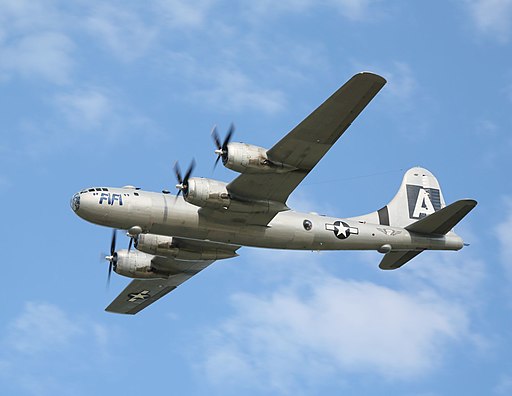The B-29 Superfortress, a four-engine propeller-driven heavy bomber, was the epitome of military aviation technology during World War II. Designed and manufactured by Boeing, this aircraft gained fame as the most technologically advanced bomber of its time, shaping the trajectory of aviation and military history.
The Genesis
Development of the B-29 Superfortress began in 1940 as a response to the U.S. Army Air Corps’ request for a bomber that could fly higher, faster, and further than anything. The aircraft was intended to replace B-17 and B-24 bombers, with a design that could fly at altitudes above 30,000 feet, speeds surpassing 350 miles per hour, and a range exceeding 5,000 miles.
Revolutionary Design
The B-29 was a marvel of engineering. It was the first bomber with pressurized crew compartments, which allowed for high-altitude flights over enemy territory. This feature dramatically improved the crew’s comfort and operational efficiency during long missions.
The Superfortress was also equipped with a state-of-the-art remote-controlled gun system. The system was networked between several gun turrets around the aircraft, all controlled by a central fire-control system. This allowed the crew to operate the gun turrets remotely, significantly increasing the aircraft’s defensive capabilities.
The Aircraft that Ended the War
The B-29 Superfortress is perhaps best known for its role in the final stages of World War II. Two of these aircraft, the Enola Gay and the Bockscar, were responsible for dropping atomic bombs on the Japanese cities of Hiroshima and Nagasaki in August 1945, effectively ending the war.
The B-29 Superfortress continued to serve in the Korean War and remained in service with the U.S. Air Force until the late 1950s, marking the end of an era dominated by propeller-driven bombers.
Legacy
The B-29 Superfortress had an indelible impact on postwar aviation development. Many of its features – such as pressurized cabins and remotely-controlled guns – became standards in later aircraft designs.
The B-29 became synonymous with ending World War II and ushering in an atomic age through its role in bombing Hiroshima and Nagasaki. However, its role is often debated and controversial. Nevertheless, it stands as evidence that its contribution ended the conflict and formed postwar society.
The B-29 Superfortress is an icon representing human creativity and technology’s role in world history. This aircraft is a reminder of technological innovations, military strategies, and historical events from its time.
Why was the B-29 so feared?
The B-29 Superfortress was feared for several reasons, primarily due to its advanced design and capabilities, making it a formidable weapon during World War II.
Long Range: The B-29 had an operational range of over 5,000 miles, which meant it could strike targets deep within enemy territory without refueling. This allowed the U.S. to launch bombing raids on Japan directly from their bases in the Marianas Islands, which wasn’t possible with earlier bomber models.
High Altitude Performance: The B-29 was designed to fly at altitudes above 30,000 feet, above the reach of many anti-aircraft guns and fighters of the time. This made the B-29 less vulnerable to attack during bombing missions.
Pressurized Cabins: The B-29 was the first bomber to feature pressurized crew compartments. This allowed the crew to operate the aircraft at high altitudes without needing oxygen masks, improving their comfort and efficiency.
Advanced Defensive Systems: The B-29 was equipped with a remote-controlled gunnery system, where gun turrets were networked and could be controlled from a central location within the aircraft. This allowed for more accurate defense against enemy fighters.
Payload Capacity: The B-29 could carry a significant bomb load, up to 20,000 pounds, more than any other bomber. This high payload capacity made the B-29 a serious threat to enemy cities and military installations.
Atomic Bomb Delivery: Perhaps the most notorious reason the B-29 was feared was its role in dropping the only two nuclear bombs ever used in warfare on the cities of Hiroshima and Nagasaki. This forever associated the B-29 with the devastating power and destruction of atomic weapons.
Overall, the B-29 Superfortress was a revolutionary aircraft that combined long range, high altitude, large payload capacity, advanced defensive systems, and the capability to deliver atomic bombs. These characteristics made it a game-changer in aerial warfare and a deeply feared weapon during World War II.
For more insights into the B-29 and other important military aircraft, visit Aces In Action. Here, you’ll find an amazing piece of artwork by Craig Tinder titled “Thunderhead of Precision,” that commemorates the crew members of the 58th Bombardment Wing, 20th Air Force and their final mission of World War II. The limited edition canvas print even includes a relic that originates from B-29 44-61975 which was accepted in July 1945 and spent its career as a training aircraft, making it a unique piece of history!
Thunderhead of Precision – B-29 Superfortress Aviation Art Print by Artist Craig Tinder
14 August 1945 – Five days after the second and final atomic bomb was dropped on Japan, B-29 Superfortress bombers of the 58th Bombardment Wing, 20th Air Force carried out their final attack of the war. As part of an all-out effort to force Japan’s unconditional surrender, nearly 200 B-29s from the 58th struck the Hikari Naval Arsenal (target code: Thunderhead). The mission was considered one of the most precise bombing missions of WWII and included no B-29 losses. At noon the following day, Emperor Hirohito made a radio broadcast announcing Japan’s intention to surrender.





Share:
The Silent Hunters: A Brief Dive into German U-Boats
From Tragedy to Triumph: The Legacy of the Titanic and Advances in Maritime Safety